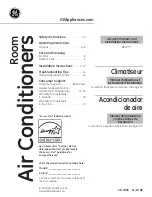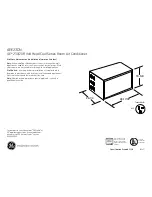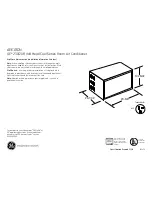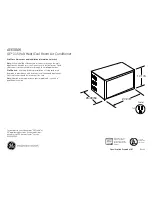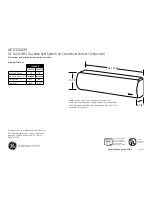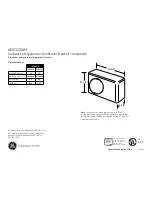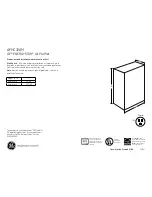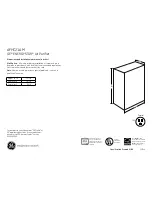
Contents
1. The following should always be observed for safety . . . . . . . . . . . . . . . . . . . .
. Selecting the installation location . . . . . . . . . . . . . . . . . . . . . . . . . . . . . . . . . . . 3
3. Installation diagram . . . . . . . . . . . . . . . . . . . . . . . . . . . . . . . . . . . . . . . . . . . . . 3
4. Refrigerant piping work . . . . . . . . . . . . . . . . . . . . . . . . . . . . . . . . . . . . . . . . . . 4
5. Electrical work . . . . . . . . . . . . . . . . . . . . . . . . . . . . . . . . . . . . . . . . . . . . . . . . . 6
6. Maintenance . . . . . . . . . . . . . . . . . . . . . . . . . . . . . . . . . . . . . . . . . . . . . . . . . . 7
1. The following should always be observed for safety
Caution:
Could lead to serious injury when operated incorrectly.
• After reading this manual, be sure to keep it together with the instruction
manual in a handy place on the customer’s site.
: Indicates a part which must be grounded.
Warning:
Carefully read the labels affixed to the main unit.
Warning:
■
Do not install the unit by yourself (user).
Improper or incomplete installation could cause fire, electric shock, injury due to
the unit falling, or water leakage. Consult a qualified installer or the dealer from
whom you purchased the unit.
■
Follow the instructions detailed in the installation manual.
Incomplete installation could cause fire or electric shock, injury due to the unit
falling, or leakage of water.
■
Install the unit securely in a place that can bear the weight of the unit.
If the installation location cannot bear the weight of the unit, the unit could fall
causing injury.
■
Perform electrical work according to the installation manual and be sure to
use an exclusive circuit. Do not connect other electrical appliances to the
circuit.
If the capacity of the power circuit is insufficient or there is incomplete electrical
work, it could result in a fire or an electric shock.
■
Ground the unit correctly.
Do not connect the ground wire to a gas pipe, water pipe, lightning rod or tele-
phone ground. Defective grounding could cause electric shock.
■
Do not damage the wires.
Damaged wires could cause fire.
■
Be sure to shut off the main power when setting up the indoor P.C. board
or wiring.
Failure to do so could cause electric shock.
■
Use the specified wires to securely connect the indoor and outdoor units.
Attach the wires firmly to avoid applying stress to the terminal block.
Improper connection could cause fire.
■
Do not install the unit in a place where flammable gas may leak.
If gas leaks and accumulates around the unit, it could cause an explosion.
■
Do not use intermediate connection of the power cord or the extension
cord. Do not connect many devices to one AC outlet.
It could cause a fire or an electric shock.
■
Use the parts provided or specified parts for the installation work.
The use of defective parts could cause an injury or leakage of water due to a
fire, an electric shock, the unit falling, etc.
■
Securely attach the electrical cover to the indoor unit and the service panel
to the outdoor unit.
If the electrical cover of the indoor unit and/or the service panel of the outdoor
unit are not attached securely, dust, water, etc. could collect in the unit and could
cause a fire or an electric shock.
■
When installing or relocating the unit, make sure that no substance other
than the specified refrigerant (R410A) enters the refrigerant circuit.
Any foreign substances in the refrigerant circuit can cause abnormal pressure
rise or an explosion.
■
Do not discharge the refrigerant into the atmosphere. Check that the refrig-
erant gas does not leak after installation has been completed. If refrigerant
leaks during installation, ventilate the room.
If refrigerant comes in contact with a fire, harmful gas could be generated.
If refrigerant gas leaks indoors, and comes into contact with the flame of a fan
heater, space heater, stove, etc., harmful gases will be generated.
■
Use appropriate tools and piping materials for installation.
The pressure of R410A is 1.6 times higher than R. Not using the appropriate
tools and materials, or improper installation could cause the pipes to burst caus-
ing an injury.
■
When pumping down the refrigerant, stop the compressor before discon-
necting the refrigerant pipes.
If the refrigerant pipes are disconnected while the compressor is running and the
stop valve is open, air could be drawn in and the pressure in the refrigeration
cycle could become abnormally high, causing the pipes to burst.
■
When installing the unit, securely connect the refrigerant pipes before
starting the compressor.
If the compressor is started before the refrigerant pipes are connected and the
stop valve is open, air could be drawn in and the pressure in the refrigeration
cycle could become abnormally high, causing the pipes to burst.
■
Fasten a flare nut with a torque wrench as specified in this manual.
If fastened too tight, a flare nut could break and cause refrigerant leakage.
■
Install the unit according to national wiring regulations.
Caution:
■
Depending on the installation area, install a Ground Fault Interrupt (GFI)
circuit breaker.
If the Ground Fault Interrupt (GFI) circuit breaker is not installed, an electric
shock could occur.
■
Perform the drainage/piping work securely according to the installation
manual.
If there is defect in the drainage/piping work, water could drip from the unit, and
damage household items.
• Please provide an exclusive circuit for the air conditioner and do not con
-
nect other electrical appliances to it.
• Be sure to read “The following should always be observed for safety” be-
fore installing the air conditioner.
• Be sure to observe the cautions specified here as they include important
items related to safety.
• The indications and meanings are as follows.
Warning:
Could lead to death or serious injury.
■
Do not touch the air inlet or the aluminum fins of the outdoor unit.
This could cause injury.
■
Do not install the outdoor unit where small animals may live.
If small animals enter the unit and damage its electrical parts, it could cause a
malfunction, smoke emission, or fire. Keep the area around the unit clean.





















